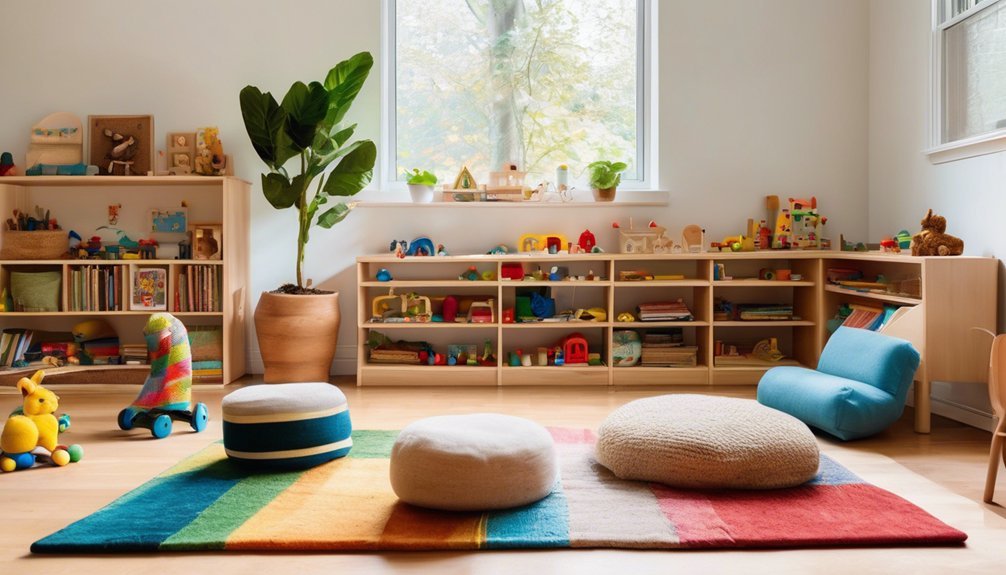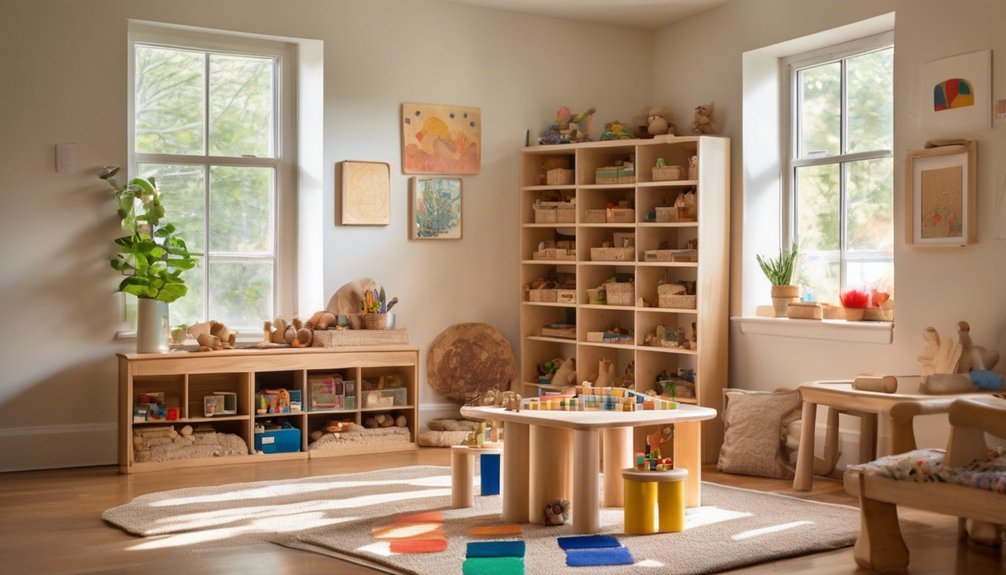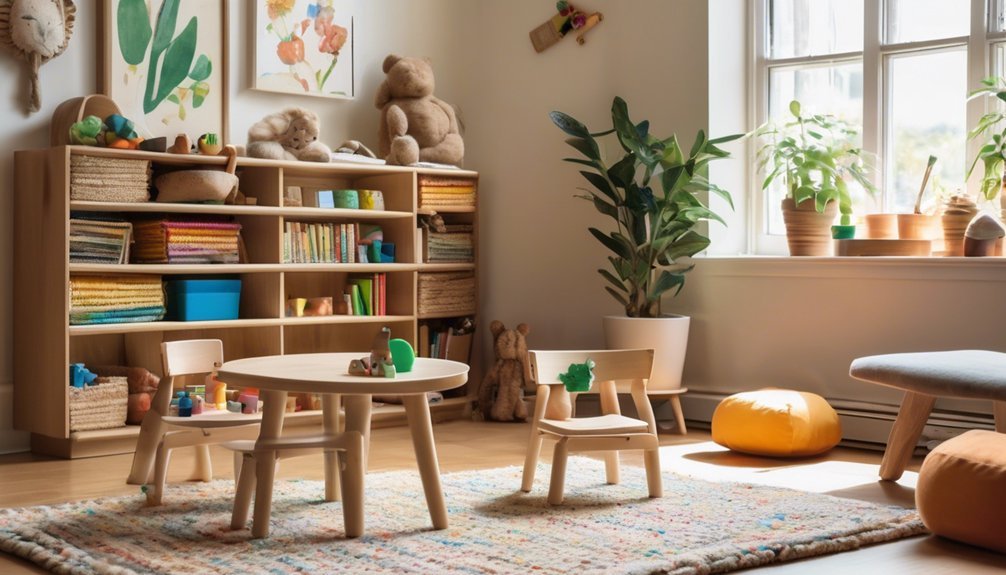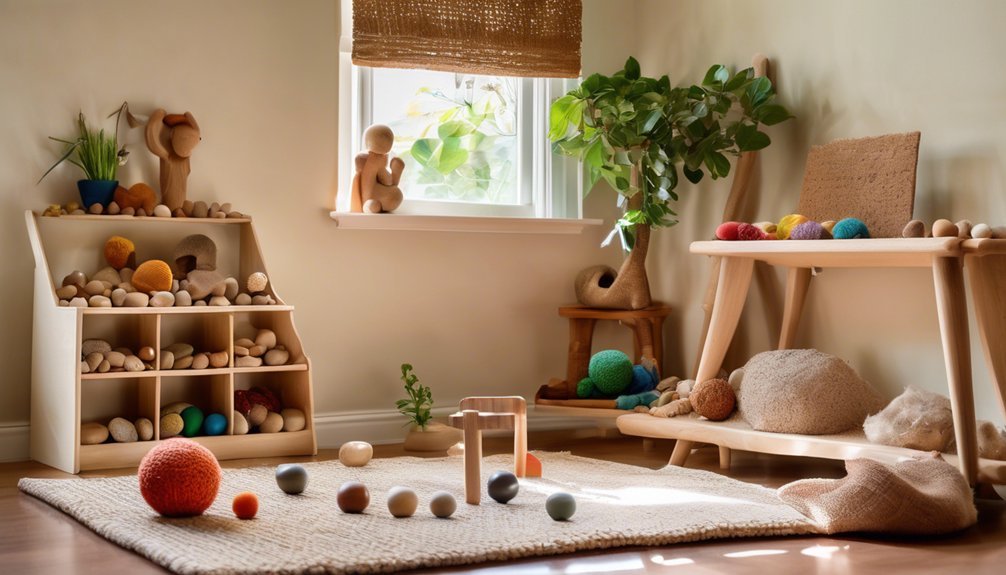Creating a Montessori corner at home can transform your child’s learning experience. Imagine a space tailored just for them, filled with materials that spark curiosity and independence. By choosing the right location and designing an inviting area, you set the stage for exploration. Think about how you can incorporate elements that promote hands-on learning. What materials will you include to capture their interest? The possibilities are exciting and worth exploring further.
Key Takeaways
- Choose a quiet, well-lit area near main living spaces to create a cozy corner conducive to exploration and learning.
- Use child-sized furniture and calming colors to promote independence and ensure the space feels inviting and safe.
- Select age-appropriate materials that align with developmental milestones, rotating them regularly to maintain interest and engagement.
- Involve your child in planning and organizing the space, encouraging them to express preferences and take ownership of their learning environment.
- Foster a joyful atmosphere that celebrates exploration and curiosity, providing open-ended materials and tools for hands-on activities.
Understanding the Montessori Method

To truly grasp the essence of the Montessori Method, you’ll want to observe how it nurtures a child’s natural curiosity and independence.
The Montessori philosophy emphasizes a child-centered approach, encouraging exploration and hands-on learning. You’ll notice children engaging deeply with materials, making choices that align with their interests, which fosters a sense of ownership over their learning.
This method supports child development by respecting each child’s unique pace, allowing them to thrive in a supportive environment. You’ll see how they develop critical thinking skills and emotional resilience as they navigate their activities.
Choosing the Right Location
Choosing the right location for your Montessori corner can significantly impact your child’s engagement and independence.
Start by observing your home’s flow and your child’s natural interests. Look for a quiet, well-lit area where they can explore without distractions.
Consider location factors like proximity to your main living spaces, ensuring it feels connected yet safe. Space optimization is key; use vertical storage to keep materials accessible but organized.
A cozy corner with a soft rug can invite your child to settle in and discover.
Designing an Inviting Space
While designing an inviting space for your Montessori corner, consider how different elements can inspire your child’s exploration and creativity.
Choose calming color schemes that evoke a sense of serenity, like soft blues or gentle greens, which can help your child feel at ease and focused.
When it comes to furniture selection, opt for child-sized pieces that encourage independence and accessibility. A low table and comfortable seating invite your little one to engage in activities freely.
Incorporate natural materials, such as wood and fabric, to create a warm atmosphere.
Remember, an inviting space should feel safe and nurturing, allowing your child to thrive.
With intentional choices, you provide a canvas for endless exploration and joyful learning.
Selecting Age-Appropriate Materials

As you create your Montessori corner, selecting age-appropriate materials is crucial for fostering your child’s natural curiosity and development. Focus on sensory materials that engage their senses and align with their developmental milestones. Observe what captures their interest, and choose items that encourage exploration and learning.
| Age Group | Material Type | Purpose |
|---|---|---|
| 0-2 years | Soft fabrics | Develops tactile awareness |
| 2-4 years | Wooden puzzles | Enhances problem-solving skills |
| 4-6 years | Art supplies | Fosters creativity and self-expression |
Incorporating Natural Elements
Incorporating natural elements into your Montessori corner can transform the space into a nurturing environment that sparks your child’s curiosity.
Use natural materials like wood, stone, and cotton to create a warm, inviting atmosphere. Consider adding small plants or herbs, allowing your little one to observe growth and changes over time.
You might even bring in outdoor elements, like seashells or pinecones, to ignite wonder and exploration. These treasures can serve as conversation starters, encouraging your child to engage their senses and imagination.
Organizing Materials for Accessibility
Creating an organized space where materials are easily accessible can significantly enhance your child’s independence and learning experience.
Start by choosing storage solutions that suit your child’s size and abilities. Use low shelves and bins that let them reach for materials confidently.
Labeling materials not only helps your child find what they need but also encourages responsibility as they learn to put things back in their place. Bright, colorful labels can spark curiosity and make the process fun.
Keep frequently used items within reach and rotate others to maintain interest. By creating this inviting environment, you empower your child to explore, learn, and thrive on their own.
Creating Defined Learning Areas

After organizing materials for accessibility, the next step is to establish defined learning areas within your home.
These learning zones create a nurturing environment where your child can explore and grow. Focus on setting up activity stations that cater to various interests and skills.
- A reading nook filled with cozy cushions and books
- An art station stocked with paper, colors, and craft supplies
- A science corner for experiments and nature observations
- A sensory play area with different textures and materials
- A math zone featuring puzzles and counting games
Encouraging Independence and Choice
As your child explores their Montessori corner, you’ll notice how vital independence and choice are for their development. By allowing them to make decisions about their activities, you’re fostering self-directed learning and enhancing their decision-making skills.
Watch as they gravitate toward materials that spark their curiosity, engaging deeply in their chosen tasks. This sense of autonomy not only builds their confidence but also nurtures their ability to think critically.
Encourage them to express their preferences, whether it’s selecting a book or choosing a hands-on activity. Celebrate their choices, reinforcing that their opinions matter.
You’re creating a space where they feel empowered, leading to a love for learning that lasts a lifetime. Embrace this journey together—it’s a beautiful one!
Incorporating Practical Life Activities
When you incorporate practical life activities into your Montessori corner, you’ll be amazed at how your child begins to develop essential skills for daily living.
These activities not only enhance their practical life skills but also make daily routines more enjoyable.
Consider including:
- Pouring: Use small containers for them to practice pouring water or grains.
- Sweeping: A child-sized broom can make cleaning feel like a fun game.
- Dressing: Offer clothes with various fasteners for them to explore.
- Food Preparation: Simple tasks like washing fruits or spreading butter can be empowering.
- Gardening: Let them help with planting or watering to connect with nature.
Adding Sensory Experiences

Incorporating practical life activities naturally leads you to explore the world of sensory experiences, which are vital for your child’s development.
Think about creating sensory bins filled with a variety of textured materials, like rice, sand, or fabric swatches. These bins invite your little one to touch, feel, and discover, enhancing their fine motor skills and encouraging imaginative play.
You might notice their excitement as they pour, scoop, and sift through the different textures, sparking curiosity and engagement.
Remember, it’s about allowing them to lead the experience, fostering independence and confidence.
As you watch their joy unfold, you’ll see how these simple sensory experiences can transform your Montessori corner into a haven of exploration and learning.
Rotating Materials and Activities
To keep your Montessori corner vibrant and engaging, regularly rotating materials and activities is essential. This keeps your little one excited and curious, nurturing their natural love for learning.
You can observe their interests and adapt accordingly, ensuring everything feels fresh and inviting.
- Introduce seasonal activities that celebrate nature.
- Swap out rotating toys to spark new imaginative play.
- Incorporate themed books related to the current season.
- Use open-ended materials for creative exploration.
- Create a mini-experiment corner for hands-on science fun.
Involving Your Child in the Process
How can you make your Montessori corner even more meaningful? Involving your child in the process is key!
Invite them into the conversation about what materials and activities spark their interest. Together, you can engage in collaborative planning, allowing them to express their preferences and ideas. This not only empowers your child but also deepens their connection to the space.
Watch as they eagerly help organize and set up their corner, making choices that reflect their unique personality. Celebrate their involvement by acknowledging their contributions, fostering a sense of pride and ownership.
Your child will thrive in an environment where they feel valued and heard, transforming learning into a joyful adventure you both embark on together.
Frequently Asked Questions
How Can I Adapt Montessori Methods for Different Learning Styles?
To adapt Montessori methods, observe how your child learns best. For visual learners, use colorful materials and charts. For auditory learners, incorporate songs and discussions. Tailor activities to nurture their unique learning styles and interests.
What Are Common Mistakes When Setting up a Montessori Corner?
Did you know that 60% of parents face organization challenges when setting up learning spaces? Avoid common pitfalls by ensuring materials are accessible and age-appropriate, creating a nurturing environment that encourages your child’s independence and exploration.
How Do I Encourage Siblings to Share the Space?
To encourage siblings to share the space, use sharing strategies like taking turns and collaborative projects. Foster sibling cooperation by praising their teamwork and creating opportunities for them to explore and learn together. They’ll thrive!
Can I Implement Montessori Principles in Small Apartments?
Absolutely! You can transform even the tiniest apartment into a Montessori haven. Embrace space optimization and minimalist design, creating cozy corners filled with engaging materials that nurture your child’s independence and curiosity. It’s all about intentionality!
What Resources Are Available for Further Montessori Education?
You’ll find a wealth of Montessori books and online courses that deepen your understanding. Embrace these resources to nurture your child’s potential, fostering their independence and curiosity in a supportive, engaging environment. You’re on a wonderful journey!
Conclusion
Creating a Montessori corner at home is like planting a seed for your child’s curiosity to grow. By designing a space that encourages exploration and independence, you’re nurturing their learning journey. Remember, it’s all about making them feel involved and valued in the process. With the right materials and a little creativity, you’ll watch their enthusiasm blossom. So, roll up your sleeves and get started—your child’s adventure in discovery is just around the corner!




